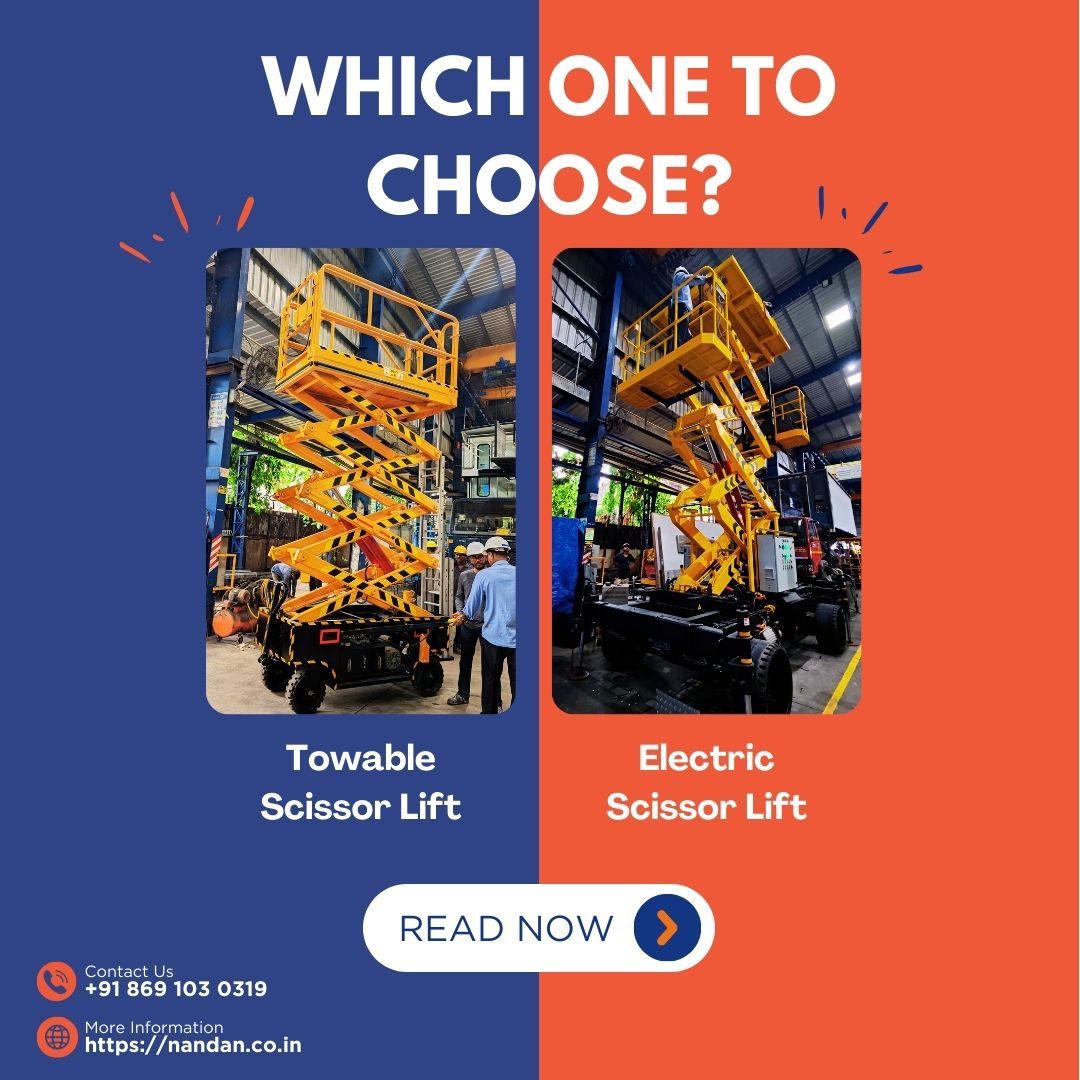Electric Scissor Lift Vs Towable Scissor Lift
- Nandan GSE
- Blogs
Home » Electric Scissor Lift Vs Towable Scissor Lift
Table of Contents
Are you weighing the options between an Electric Scissor Lift and a Towable Scissor Lift for your next project? Choosing can be challenging. Each has unique benefits and drawbacks. In this blog, we’ll delve into both, aiding your decision. Electric Scissor Lifts shine with quiet operation and no emissions. They fit indoor jobs or sensitive outdoor areas well. Conversely, Towable Scissor Lifts excel in mobility. They suit projects needing frequent moves or long transports. We’ll also discuss factors like height, weight capacity, maneuverability, and costs. By this article’s end, the differences between Electric Scissor Lifts and Towable Scissor Lifts will be clear. This knowledge will guide you to the best choice for your project. Let’s explore and identify the ideal lift for you!
Key Differences Between Electric Scissor Lift & Towable Scissor Lift
Electric Scissor Lifts and Towable Scissor Lifts differ mainly in power source and mobility. Electric lifts use batteries. They are quiet and eco-friendly. Towable lifts, however, attach to vehicles for movement. They offer greater flexibility in location. Electric models are typically smaller and lighter. This makes them ideal for indoor use or smooth surfaces. Towable lifts can handle rougher terrain. They are better for outdoor sites. Electric lifts need charging, limiting their use time. Towable lifts, powered by vehicles, don’t have this limit. Thus, your project’s nature greatly influences the choice.

Factors To Consider When Choosing Between Electric & Towable Scissor Lifts
When deciding, consider several key factors. First, think about the project location. Indoor or noise-sensitive areas favor electric lifts. Outdoor or varied sites may require towable lifts. Next, assess the need for mobility. Frequent moves make towable lifts appealing. Also, consider the surface and terrain. Electric lifts suit smooth, solid grounds. Towable lifts can navigate rougher surfaces. Lastly, weigh the duration and power availability. Electric lifts need charging. Projects without easy access to power might benefit from towable lifts.
Advantages Of Electric Scissor Lifts
Electric Scissor Lifts have distinct benefits. Their quiet, emission-free operation protects indoor air quality. This is crucial for enclosed spaces. They are also more compact. This allows access to tighter areas. Their lower weight reduces floor damage risk. Battery operation eliminates the need for fuel. This can lower operating costs. Electric lifts often have lower maintenance needs than their towable counterparts. They are perfect for projects with environmental or noise considerations.
Advantages Of Towable Scissor Lifts
Towable Scissor Lifts stand out for different reasons. Their main advantage is mobility. They easily move between sites. This flexibility is invaluable for multi-location projects. They are also ideal for outdoor use. Their design handles uneven terrain better. Towable lifts do not require a power source on site. This makes them suitable for remote or undeveloped areas. They can be more cost-effective for short-term projects. Their ease of transport reduces logistical challenges.
Common Applications For Electric Scissor Lifts
Electric Scissor Lifts are widely used in several settings. Indoor construction and maintenance benefit from their quiet operation. They are preferred in malls, hospitals, and schools. Electric lifts also serve well in warehouse stocking. Their compact size allows navigation in narrow aisles. Maintenance work in residential areas often uses electric lifts. Their noiseless operation is less disruptive. Electric lifts are the go-to for environmentally sensitive projects.
Common Applications For Towable Scissor Lifts
Towable Scissor Lifts find their niche in varied applications. They are a top choice for outdoor construction. Landscaping projects also benefit from their mobility. Events and festivals use towable lifts for setup and takedown. Their ease of transport makes them perfect for jobs across multiple sites. Towable lifts also support painting and exterior maintenance. Their versatility makes them indispensable for projects without onsite power.
Cost Considerations For Electric And Towable Scissor Lifts
Costs for Electric and Towable Scissor Lifts vary. Initial purchase price is one aspect. Electric lifts may cost more upfront but offer savings on fuel and maintenance. Towable lifts, while potentially cheaper initially, might incur higher operating costs. Rental prices also differ. The project’s length and lift usage frequency affect the choice. Electric lifts could be more economical for long-term, indoor use. Towable lifts might be better for short, varied-location projects. Always consider the total cost of ownership.
Conclusion: Choosing The Right Scissor Lift For Your Project
Deciding between an Electric Scissor Lift and a Towable Scissor Lift is crucial. Each has unique advantages tailored to different project needs. Electric lifts offer quiet, emission-free operation. They are ideal for indoor or noise-sensitive environments. Towable lifts provide unmatched mobility and flexibility. They excel in outdoor or varied-location projects.
Consider your project’s location, mobility needs, and the terrain it will encounter. Also, factor in the duration of your project and available power sources. Cost is another important consideration. Think about both the upfront investment and the long-term operating expenses.
In summary, your choice should align with your project’s specific requirements. For indoor, environmentally sensitive, or noise-restricted areas, Electric Scissor Lifts are preferable. For outdoor, rough terrain, or projects requiring high mobility, Towable Scissor Lifts are the better option. By carefully weighing these factors, you can select the right scissor lift. This choice ensures efficiency, safety, and cost-effectiveness for your project.
Contact Us
Please fill up the below details our executive will call you shortly.
